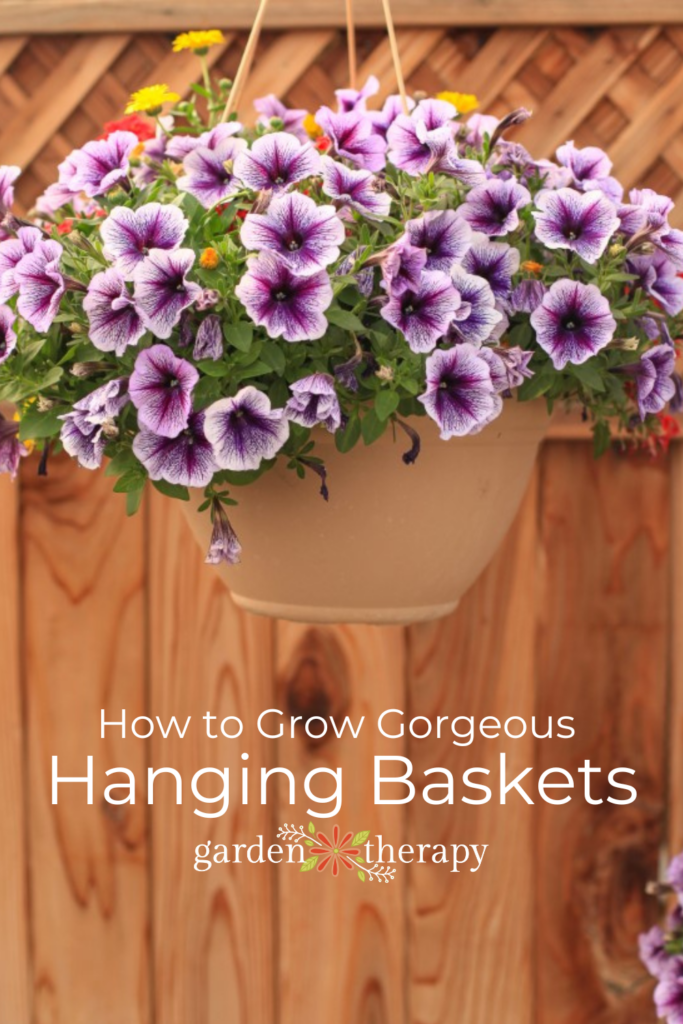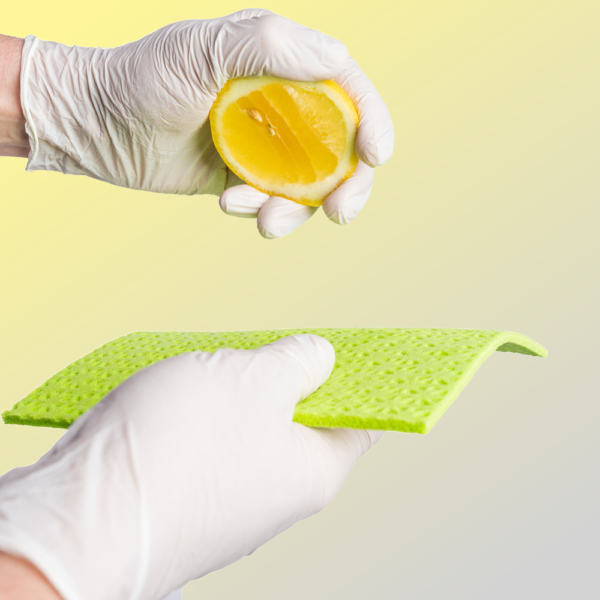Hanging baskets are ever-growing in popularity. However, unless you care for those a little differently from in-ground plants, they can get ratty-looking instead of full, gorgeous hanging basket flowers. Here are the tips you need for beautiful eye-level plants and bright flowers all summer long.
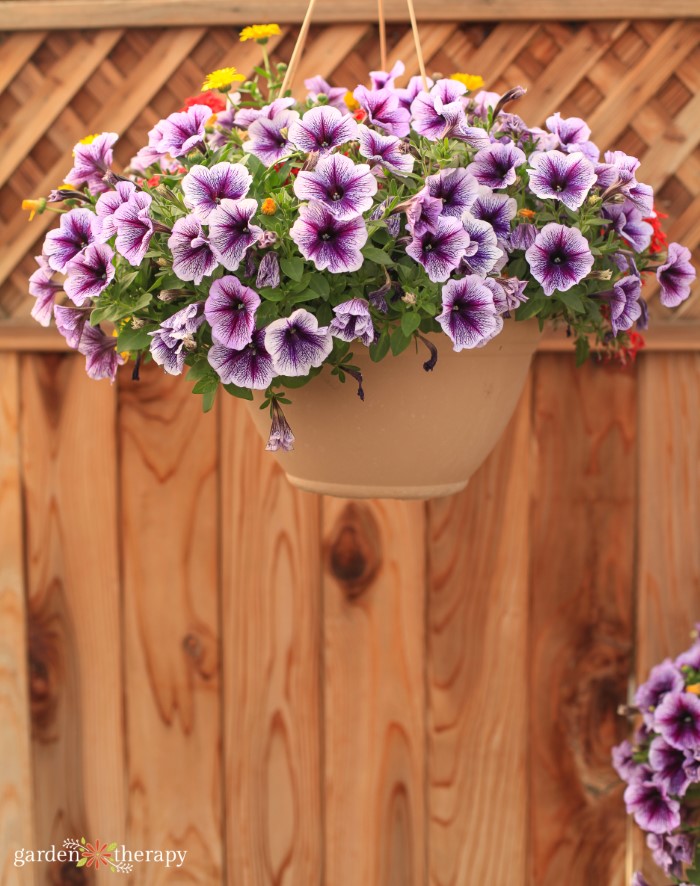
Have you walked (or driven) by gorgeous hanging baskets and been awed by their beauty? Then, perhaps, you got the idea to try growing similar baskets yourself, only to fail miserably?
Let me just tell you right now that you are not the only one! Many have tried and many have failed.
A properly-planted, well-cared-for hanging basket can brighten up your front entrance or back patio immensely. Although hanging baskets can be a bit tricky, this guide for choosing the right plants, watering correctly, and caring for hanging containers makes it easy to plant and maintain a beautiful blooming basket all summer long.
Now, you, too, can grow lush, drool-worthy hanging basket plants that will make you the envy of the neighbourhood.
In this post, we’ll cover…
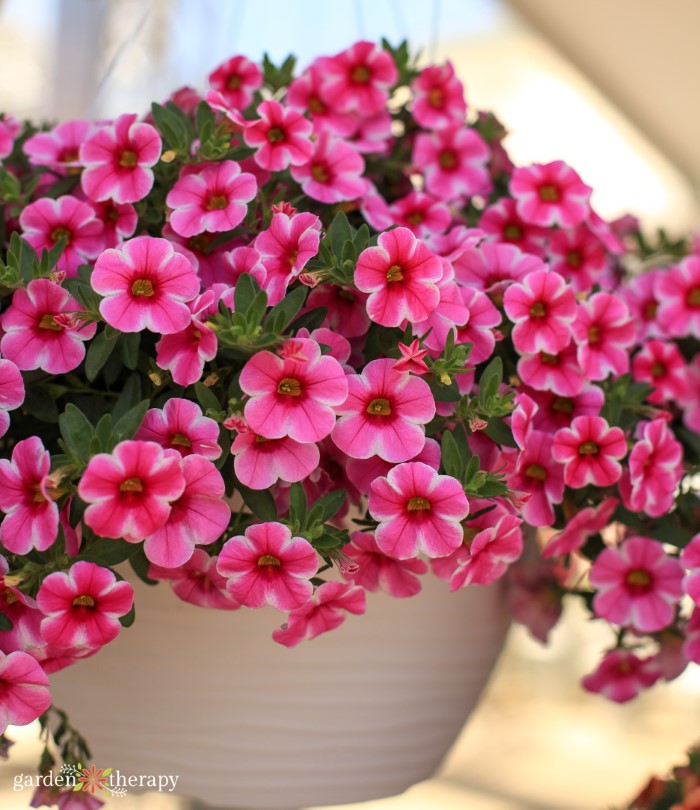
The Benefits of Growing Outdoor Hanging Plants
I mentioned the biggest deterrent to growing flowers for hanging baskets: they can dry out too quickly and die.
Now, let’s cover why you want to put in a wee bit of effort to grow hanging basket plants. There are actually a few advantages of hanging basket flowers over gardening in the ground:
- Growing a basket of flowers gives you that pop of colour you crave without the work of digging in the ground.
- Do you have poor soil? That’s not even an issue when growing hanging basket plants.
- Fitting several plants into one single planter leaves little space for annoying weeds, thus nearly eliminating weeding chores.
- Since the baskets hang up off the ground, they are safe from flower-eating animals and many pests.
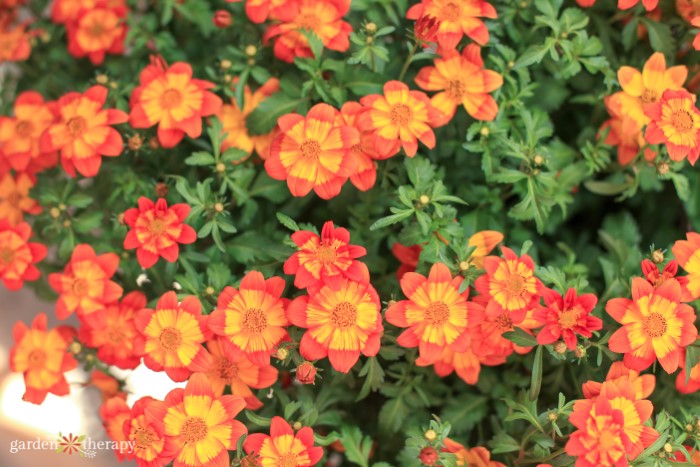
How to Properly Care for Hanging Basket Flowers All Summer
The key to success with hanging baskets comes down to one simple thing to remember: hanging baskets need to be treated differently than in-ground plants. Nail these six elements to properly care for your hanging baskets, and you’ll have the beautiful hanging basket plants you seek.
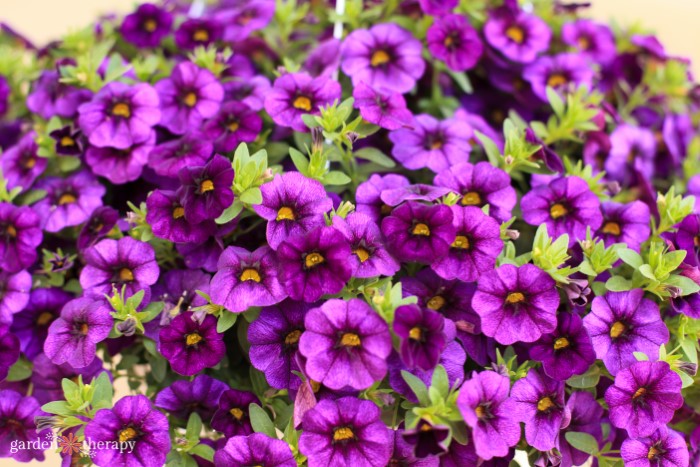
Choose the Right Hanging Baskets
Since watering problems are the most common way that people kill hanging plants, start with your hanging basket planter. You want to make sure that it:
- Has good drainage holes so water doesn’t stay trapped and drown the roots of your planter flowers.
- It is large enough to accommodate the plants you want to include.
Remember to get a hanging basket that’s as deep as you can find to hold a good amount of soil and water for your plants.
Take a look at this post if you want to attempt designing your own hanging baskets!
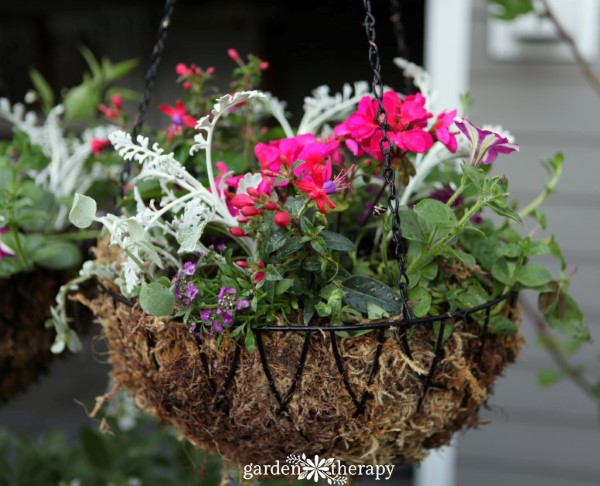
Choose the Right Hanging Basket Plants
When putting together a hanging basket, think about where you plan to hang it. Is it a place with a lot of hot sunshine? If so, make sure you’re choosing plants that love the heat. Is it a shadier area? If so, choose plants that will thrive in the shade.
No matter what the light and temperature conditions are for the spot where you want your basket to hang, be sure to pick plants that are appropriate for those conditions.
Also, think about what kind of plants will look most aesthetically pleasing in a hanging planter. Plants that spill over the edge and trail down look lovely.
A good rule of thumb: if you want various plants in one basket (although just sticking to one kind of plant in a basket can be gorgeous!), choose thrillers, spillers, and fillers as outlined in this post.
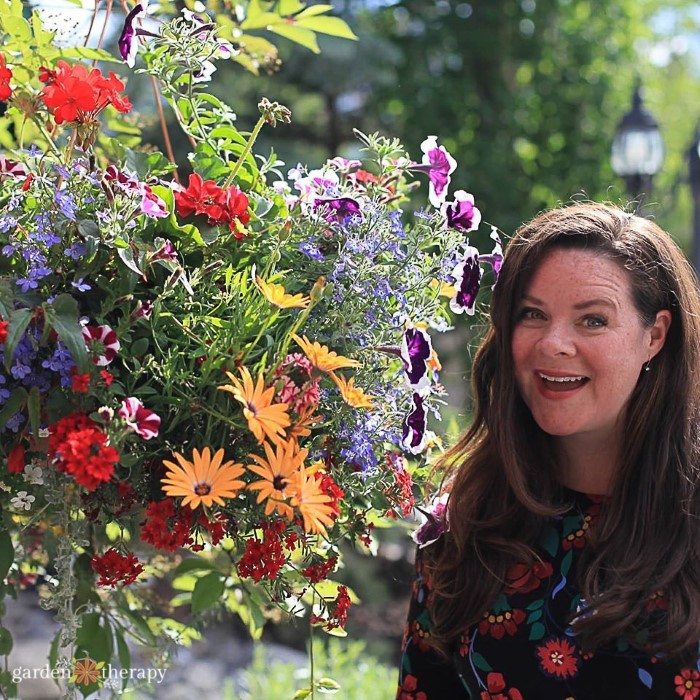
Properly Watering Flowers for Hanging Baskets
Water drains out of hanging baskets very quickly. Additionally, having many plants in one fairly small container means that many roots packed together under the soil compete for water.
These combined issues mean that it is easy for hanging basket flowers to dry out much faster than if those same plants were growing elsewhere. Here are some techniques to keep your hanging flowers moist, happy, and blooming:
- Water regularly!
- Use a plastic liner inside the hanging basket to keep moisture in.
- Try using a self-watering system like a bottle or bulb. These tools add water to the soil as it dries out. Another option is to invest in self-watering planters.
- If plants are still dropping, start giving your hanging baskets a soak once a week. Simply take the basket down from its hanger and soak it in a tub of water for a couple of hours, then hang it back up.
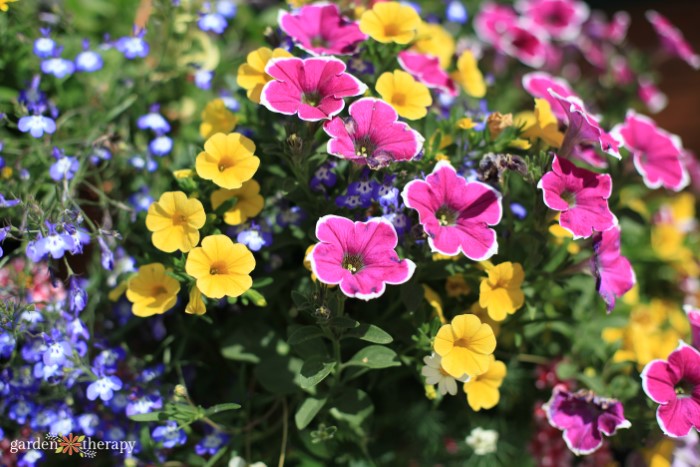
Maintain Nutritious Soil for Outdoor Hanging Plants
Because hanging baskets are, well, hanging, the soil is not exposed to nearly the same amount of microbes, bacteria, and insects that normally work to improve the soil in the garden. In addition, the more frequent watering needs flush out the essential nutrients that your plants need.
To make up for this, fertilize hanging baskets regularly or add some slow-release feeding spikes to do the job for you. Psssst, scroll to the bottom of this post for my hanging basket fertilizer recipe.
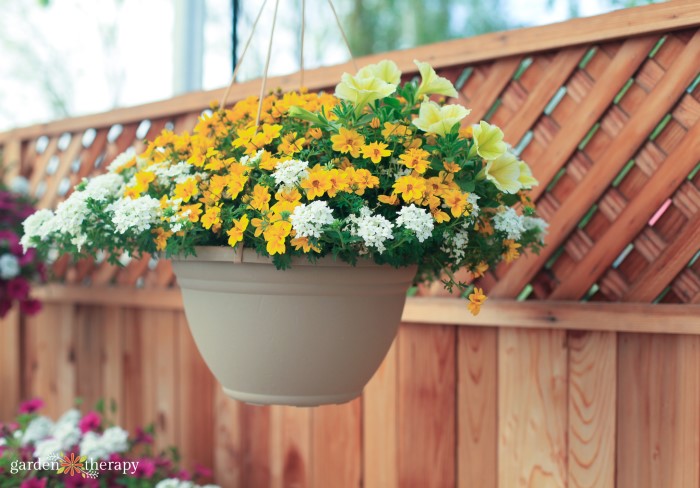
Deadhead and Prune Hanging Basket Flowers
Once a week, inspect your hanging basket and remove any dead or fading flowers and brown leaves. Cut back any part of the plant that looks dead, brown, or damaged. This will encourage new growth, more blooms, and make your hanging baskets look lush and full.
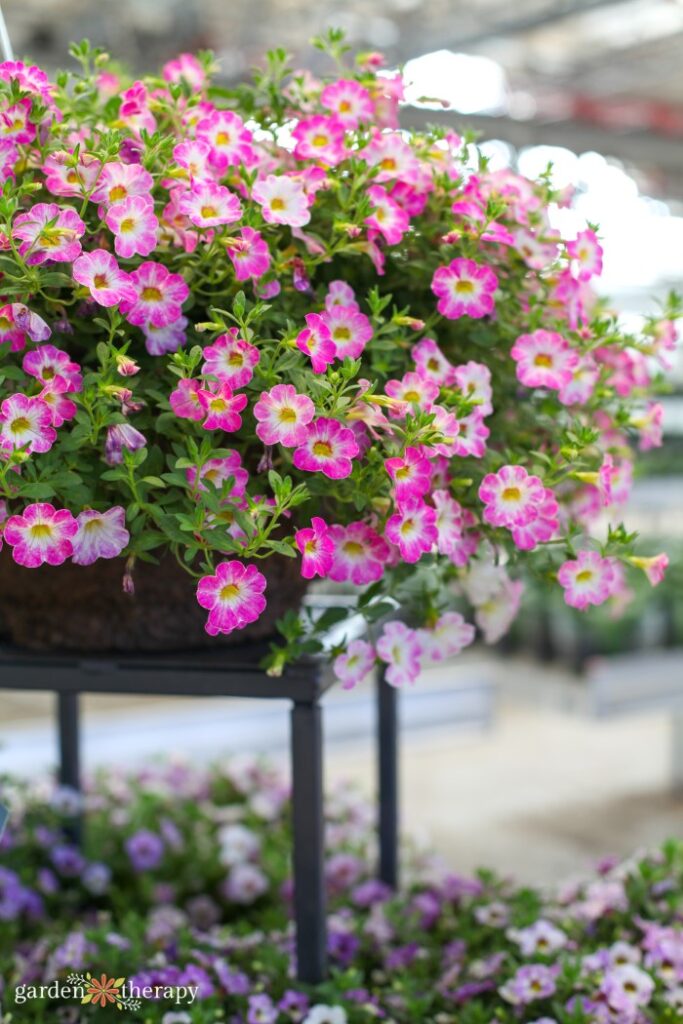
Common Hanging Basket Problems
This section is full of proper care tips that will help you keep your hanging basket not just alive but absolutely lush throughout the season.
Why do my hanging baskets die?
Hanging baskets are typically filled with annuals, which are plants that last for a season and then need to be replaced. Even perennial plants that grow back year after year will need to be replaced or significantly pruned in order to continue growing in a hanging basket after one season.
A hanging basket is a temporary planter that’s used for decoration but certainly not something that’s meant to be produced for years without maintenance.
Understanding the basics of the growing conditions can help reduce the chances that the hanging basket will die.
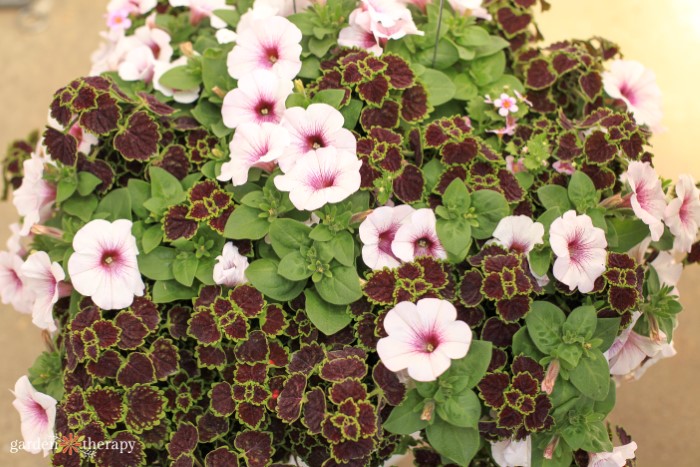
How often should I water a hanging basket?
Hanging baskets need to be watered regularly throughout the growing season. In most cases, many plants are competing for root space in the soil, so there is less space for the soil to hold water.
That, in combination with the drainage that happens from a basket hanging in the air, means that your hanging basket should be watered much more often than in-ground gardens.
If your hanging basket is in a sunny location, then you will need to water it at least once a day and sometimes twice in the heat of summer. If the hanging basket is in a shadier location, however, you might be able to go for a few days between watering.
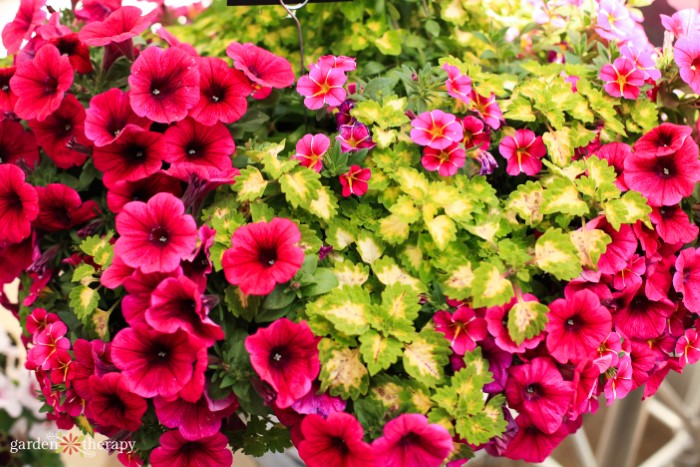
How to check if your hanging basket needs to be watered?
Check to see if the soil is dry by sticking your finger into the top of the soil. If it feels warm and dry, then it needs to be watered; if the soil feels cool, then it can wait another day.
Ideally, watering should be done slowly, allowing the soil to absorb the water. Pour the water on the surface of the basket so that you can see it sparkling but not pooling on the soil. When the water starts to pour out the bottom of the basket, the soil has been saturated.
If the soil has dried out, it will need to be rehydrated by soaking it in water for a few hours.
If you happen to be going away on vacation or won’t be able to water your hanging baskets for a few days, set up a kiddie pool or big tub with a couple of inches of water and set your hanging baskets in it when you go away. This will allow your hanging baskets to stay hydrated while you take a break from daily watering.
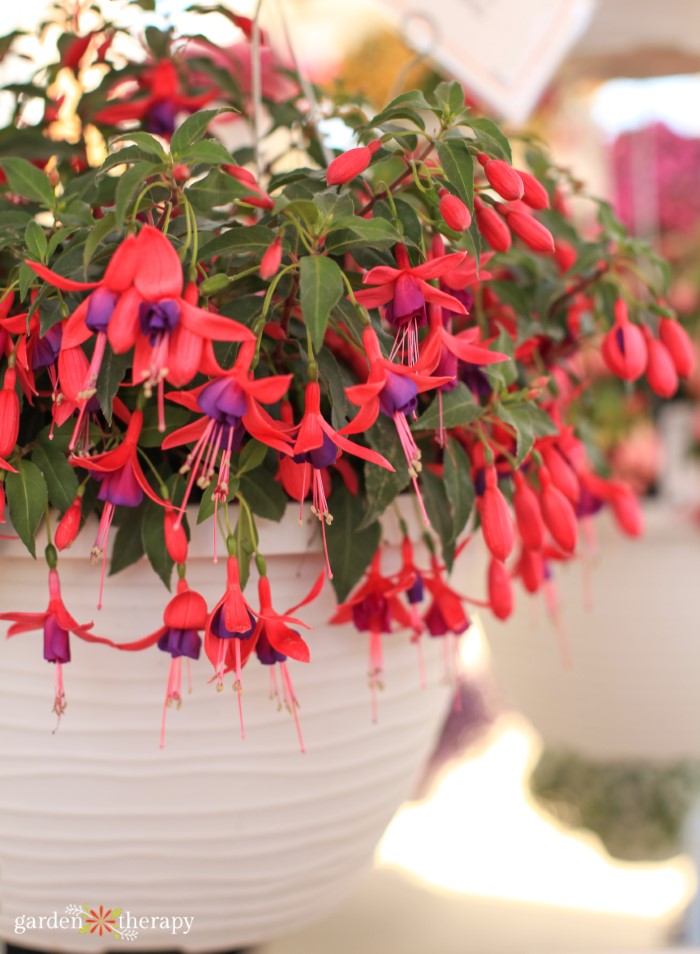
Should you line a hanging basket with plastic?
With proper drainage in your baskets, overwatering and root rot are unlikely. However, lining the basket with something to hold in water could be problematic.
Some hanging baskets have plastic liners to hold in moisture, but most annual plants require free-draining soil in order to keep their roots healthy. You can also find self-watering hanging baskets that hold a small reservoir of water below the basket for roots to access when they need it.
You can also use clear plastic trays that hang on a hanging basket to help collect the water and hold it below.
All of these tools may allow you to go a few days extra without watering, but they will require additional management to ensure that the roots don’t sit in standing water, which can cause them to rot.
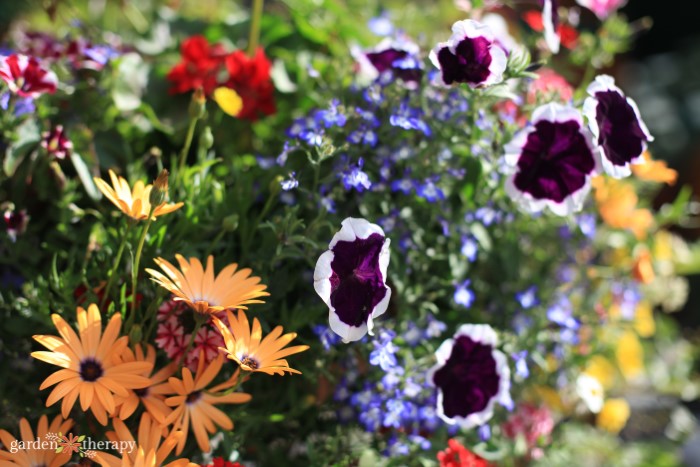
What is the best fertilizer for hanging baskets?
My favourite fertilizer mix for hanging baskets is a homemade mix from my book, Garden Alchemy!
This soil mix is excellent at holding moisture and is highly nutritious for your hanging basket flowers. Use this every two weeks, and you should see your flowers thrive!
Get the recipe for my fertilizer mix in the recipe card at the bottom of this post.

How do you revive a hanging flower basket?
Hanging baskets that you’ve hung up at the beginning of the season can look a little overgrown, brown, and straggly. This is a fairly easy fix.
Follow basic pruning rules to clean up the basket. Use scissors to remove any dead, diseased, damaged, or dying plant material. Even if this means cutting off half of the planter, you’re removing plant material that’s taking away energy from reproducing healthy plant material, and it will perk back up in no time.
Go back to my vacation rehydration tips and fill a kiddie pool or a tub with water and submerge the basket for an hour or two to give the plants a deep drink.
Top up the basket with a few handfuls of good quality compost, and add a bit more hanging basket fertilizer mix (recipe at the end of this post).
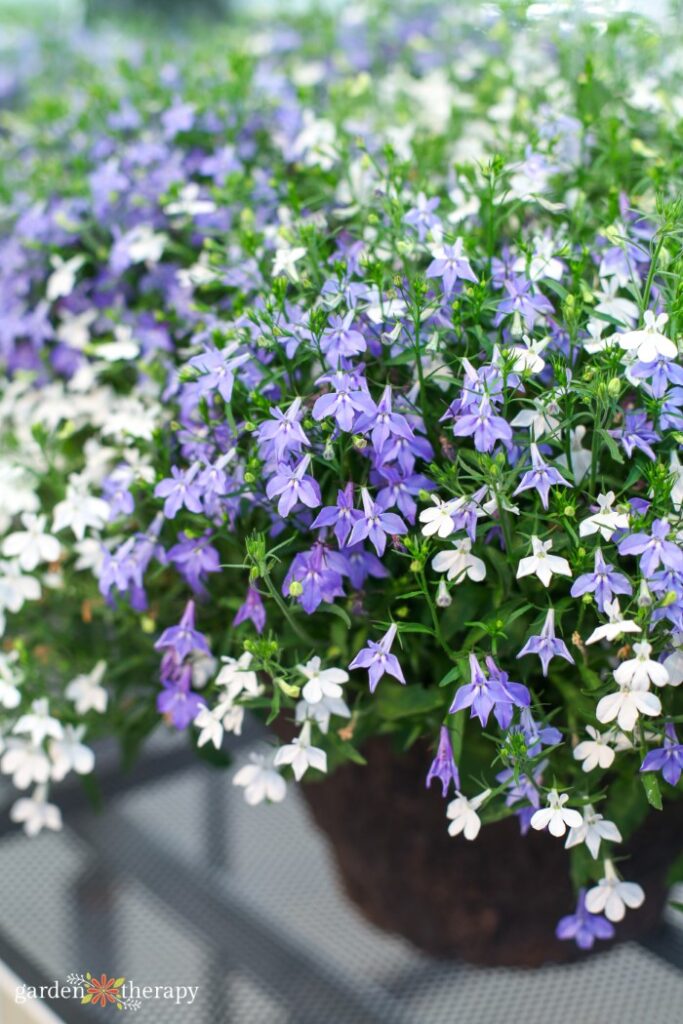
More Tips for Hanging Basket Flowers
The Best Fertilizer for Hanging Basket Flowers
If you have hanging basket flowers that are looking a little sickly, whip up a batch of my DIY hanging basket fertilizer and perk them up.

